Key takeaways:
- Initial excitement for Swift stemmed from its clean syntax and emphasis on safety and performance, igniting a passion for development.
- Understanding concurrency concepts like async/await and structured concurrency significantly improved app performance and user experience.
- Learning to handle errors within concurrent programming allowed for more resilient applications, transforming challenges into opportunities for growth.
- Building real-world applications with Swift concurrency showcased its power in creating responsive, collaborative, and efficient user experiences.
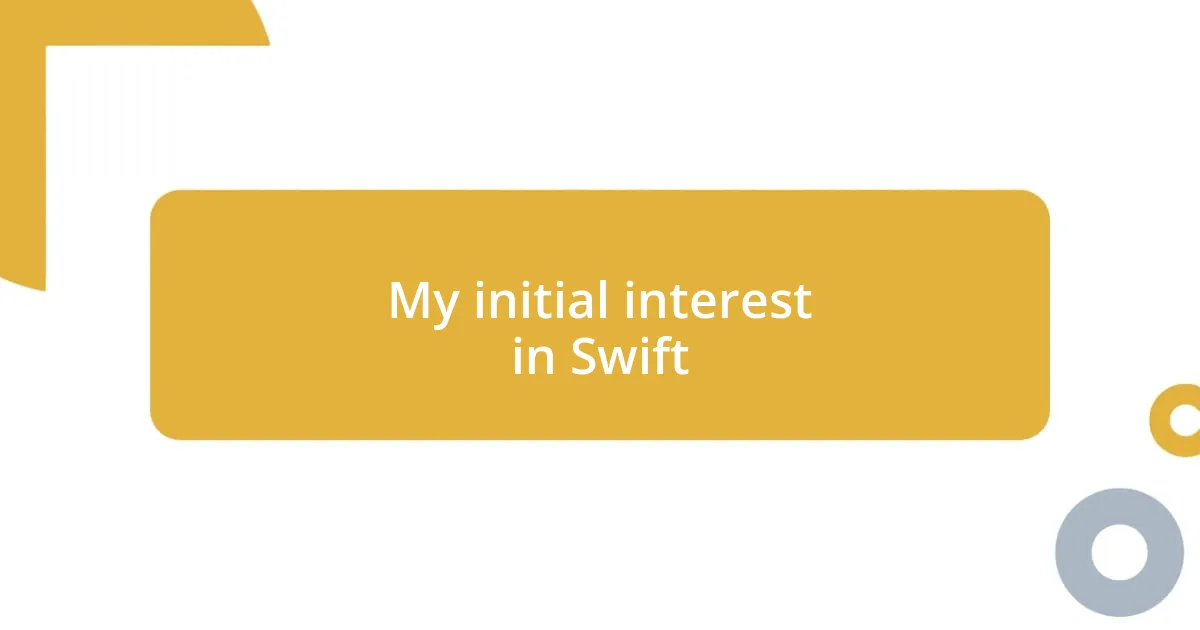
My initial interest in Swift
I remember the moment I stumbled upon Swift while searching for a seamless way to build an iOS app. As I delved into its clean and modern syntax, I couldn’t help but feel a spark of excitement. Was this the language that could unlock my creativity and offer me the tools to bring my ideas to life?
What really drew me in was Swift’s emphasis on safety and performance. The first time I successfully ran a playground and saw my code come to life with immediate feedback, I felt a rush that reminded me of riding a bike for the first time. Isn’t it fascinating how a simple line of code can transform into something dynamic and functional?
After experimenting with swift’s features, I realized it wasn’t just about writing code; it was about creating experiences. This was the kind of change I wanted to embrace. Could a programming language truly ignite a passion for development in the same way a good book can inspire a reader? For me, the answer was a resounding yes.
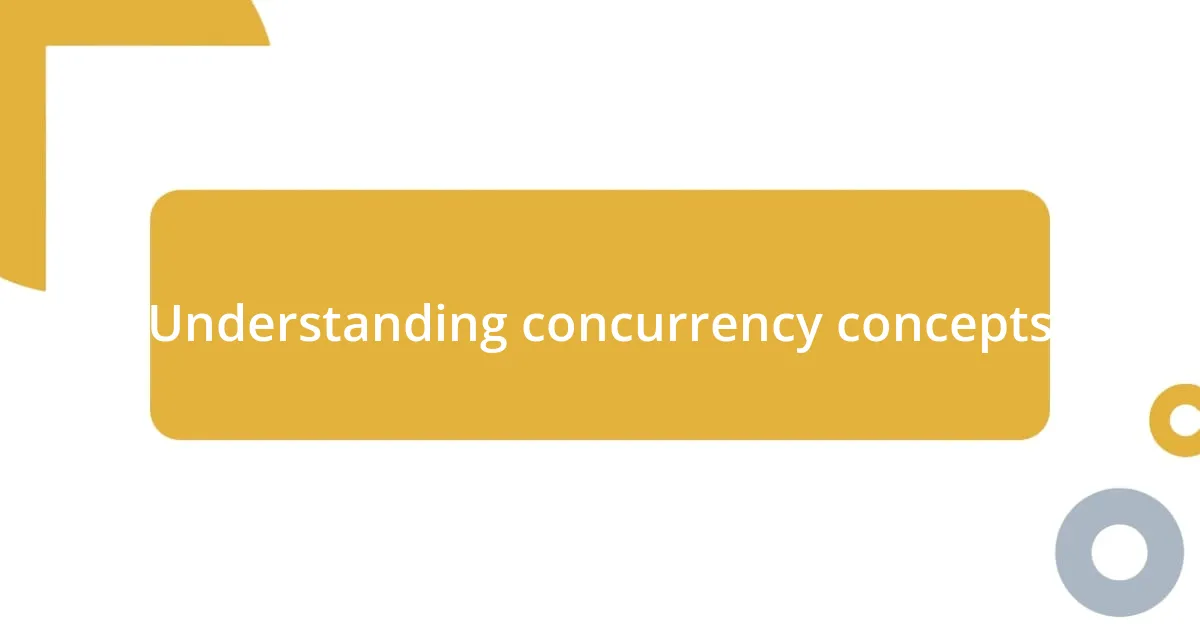
Understanding concurrency concepts
Understanding concurrency concepts can be a game changer when you’re venturing into Swift, especially if you aspire to build responsive and efficient applications. I recall grappling with the idea that a program could perform multiple tasks simultaneously. It felt a bit like trying to juggle—exciting yet daunting. But once I wrapped my head around it, I realized concurrency is fundamentally about improving performance and user experience.
Here are a few key concepts to grasp:
-
Threads: The basic units of parallelism providing a way for your program to run multiple operations at once.
-
Grand Central Dispatch (GCD): A powerful tool for managing concurrent operations, helping to efficiently distribute tasks across available threads.
-
Asynchronous Programming: A model that allows tasks to run in the background, making your app feel snappier and more responsive.
-
Actors: In Swift, actors help to manage state in a concurrent environment, preventing data races by ensuring that only one task can access the actor’s data at a time.
-
Task: A lightweight unit of work introduced in Swift Concurrency, simplifying the creation and management of concurrent code.
Understanding these concepts opened my eyes to a world of possibilities. I remember the first time I implemented GCD; it felt like unlocking a new level in a game. The app became more fluid, and I could finally see the impact of my learning in real-time. Embracing concurrency isn’t just about making an app faster; it’s about crafting a better experience for users, and that truly excites me every time I write code.

Exploring Swift’s concurrency features
Exploring Swift’s concurrency features has been like opening a door to a new universe of programming. From my experience, Swift’s structured approach to concurrency makes it easier to write efficient and safe asynchronous code. I remember grappling with the transition from synchronous to asynchronous methods; it felt like moving from physical books to a digital library—endless possibilities and resources at my fingertips.
One standout feature of Swift’s concurrency is the introduction of async/await syntax. When I first started using this, I felt an immediate improvement in the readability of my code. It was as if I had traded in my cluttered workspace for a well-organized desk. With async/await, handling asynchronous operations became intuitive, allowing me to focus on what my code was meant to accomplish rather than getting entangled in callbacks and completion handlers.
Another aspect that truly resonated with me was the concept of structured concurrency. This approach ensures tasks are managed within a specific scope, leading to cleaner and more maintainable code. I recall a project where I had multiple network requests running, and when I applied structured concurrency, it not only improved the performance but also reduced the cognitive load of managing those requests—like finally finding the right roadmap during a long road trip.
| Feature | Description |
|---|---|
| Async/Await | Simplifies writing asynchronous code, making it clearer and more readable. |
| Grand Central Dispatch (GCD) | Enables concurrent task management by distributing tasks among available threads. |
| Structured Concurrency | Guarantees all tasks complete before exiting the scope, leading to a cleaner management. |
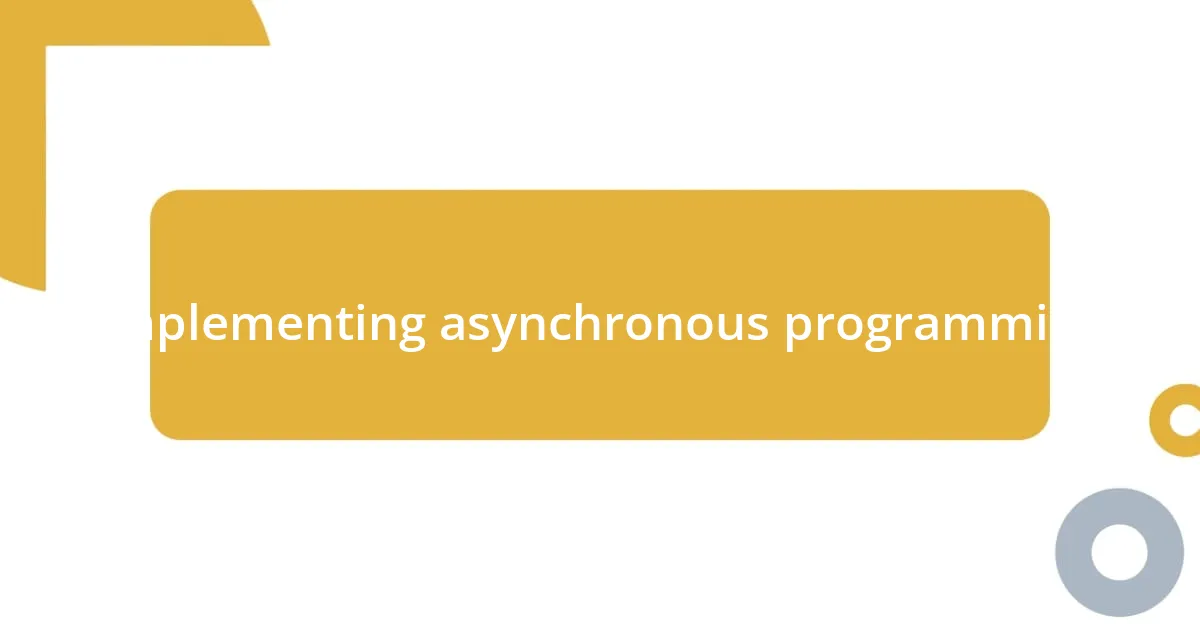
Implementing asynchronous programming
Implementing asynchronous programming has transformed the way I structure my apps. I still vividly remember the initial project where I decided to incorporate asynchronous calls for network requests. The difference in user experience was palpable; users could interact with the app seamlessly without being thrown into the void of a freezing interface. It made me realize how critical it is to keep the main thread responsive. Have you ever felt frustration while waiting for an app to load? Asynchronous programming works to eliminate that annoyance.
One of the first techniques I mastered was using async/await to simplify my code. I recall a moment of clarity when I rewrote a particularly convoluted function. The original logic was buried under layers of callbacks, making it hard to read. Transitioning to async/await felt like trading in an old, rusty car for a shiny new model—everything became smoother, and I could finally read my own code without furrowing my brow. I started to appreciate how Swift made complex tasks feel manageable and straightforward.
Another eye-opening experience was when I experimented with structured concurrency. I found myself juggling multiple tasks, trying to ensure they completed in the right order. Implementing this approach allowed me to treat my tasks as a group, almost like a team working together toward a common goal. It not only improved my app’s performance but also made debugging a lot easier. Wouldn’t it be great to know all your tasks are neatly organized, just waiting for completion? That’s the beauty of structured concurrency—it brings order to the chaos in a way that significantly enhances both development and user experience.
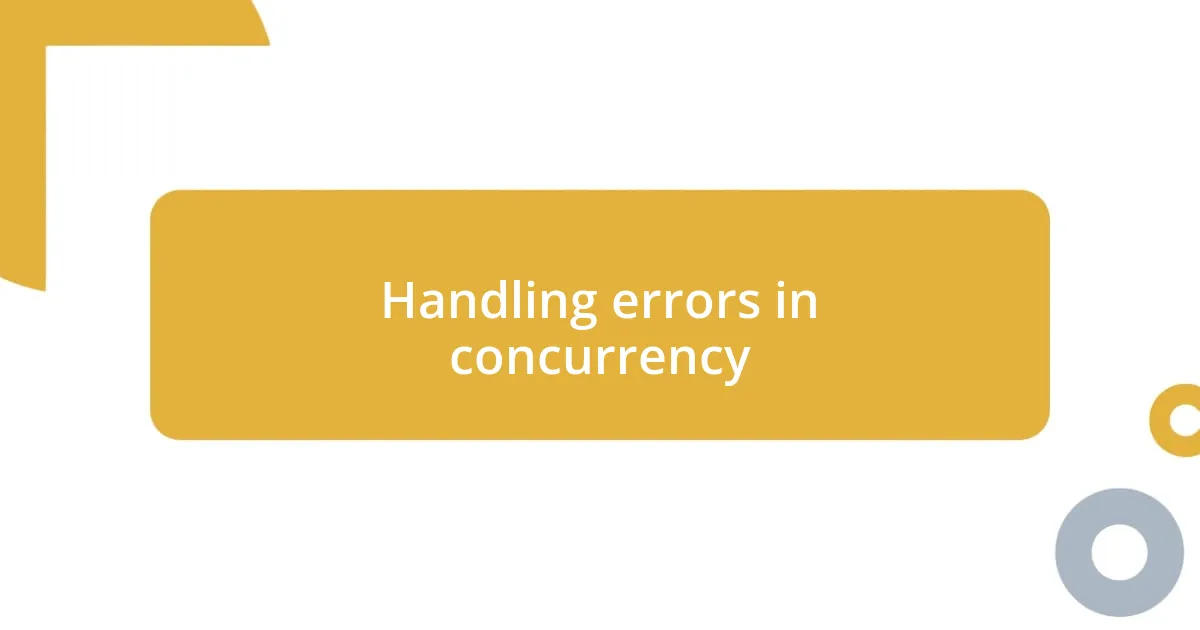
Handling errors in concurrency
Handling errors in concurrent programming can feel overwhelming at times. When I first encountered error propagation in Swift’s concurrency model, it was like trying to catch falling leaves on a windy day—a bit chaotic. Swift provides tools that allow you to handle errors gracefully, using do, try, and catch blocks within your async functions. This way, if something goes awry, you can handle the issue right where it occurs, making your code cleaner and more robust.
One memorable experience I had was dealing with a series of API calls that relied on each other. When one call failed, I initially found that my entire process fell apart. It was frustrating! Upon learning to use structured concurrency to manage my tasks, I could catch errors appropriately at each stage. This meant that even if one request failed, the rest could continue, allowing me to handle the errors and retry where necessary—almost like a safety net that kept everything together.
I often reflect on how enriching it is to embrace error handling in concurrency. It not only ensures a smoother user experience, but I felt a sense of empowerment knowing that I was building resilience into my applications. Have you ever experienced the relief of having a well-structured error-handling system in your code? In my case, it transformed my approach to coding, as I knew I could tackle unexpected challenges without fear. With practice, I found that effectively managing errors in concurrency has become one of my most valuable skills as a developer.
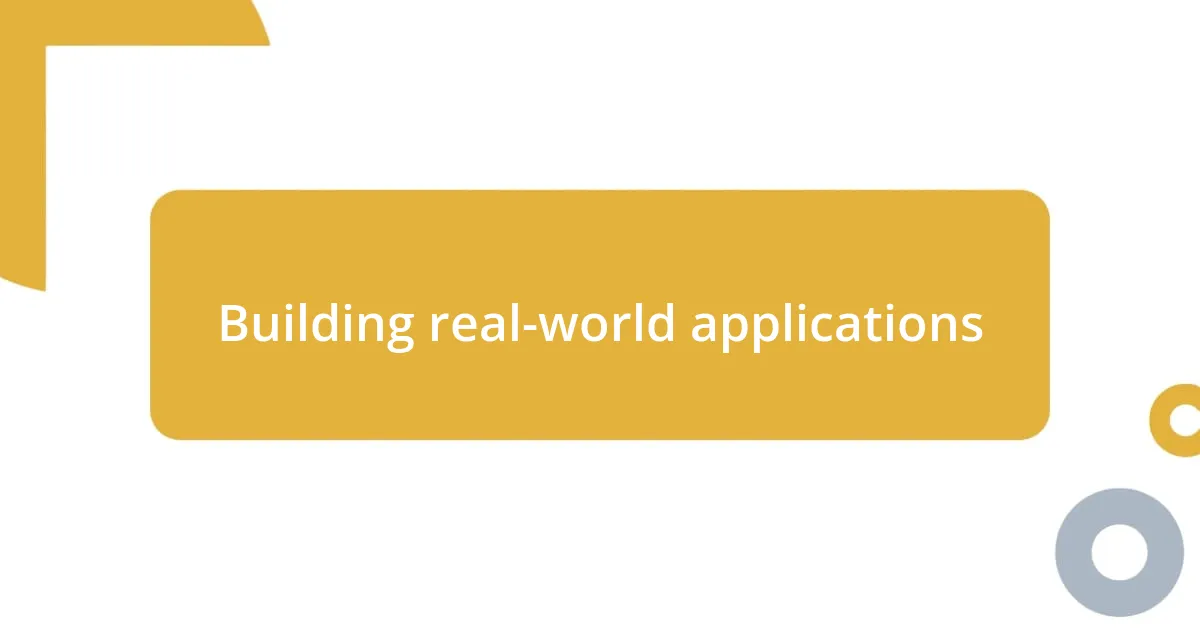
Building real-world applications
Building real-world applications with Swift concurrency has been an incredibly rewarding journey for me. I remember when I set out to develop a weather app that fetched data from various APIs. Initially, I struggled with blocking calls that froze the interface. However, switching to async/await transformed that experience. The app became responsive, and I could watch my users enjoying it without the frustration of long load times. Can you imagine the satisfaction of seeing your app run smoothly while delivering data in real-time?
As I delved deeper into structured concurrency, I tackled another project that involved managing multiple timers for reminders. I felt a sense of thrill as I organized my tasks in a way that mirrored teamwork. This structure not only simplified the code but also vastly improved the app’s performance. It was like watching a well-rehearsed orchestra; each task played its part harmoniously. Have you ever been amazed by how well-organized efforts can achieve more together than individually? That’s the beauty of applying structured concurrency—it ensures that each function is in sync and supports one another, ultimately enhancing the user’s experience.
One of the standout memories from my development path was integrating Swift concurrency into a collaborative notes app. I vividly remember how real-time updates could lead to quick miscommunications. After implementing async features, I noticed a significant reduction in delays. Whenever one user edited a note, others saw the changes instantaneously. This level of interaction made me realize how powerful Swift concurrency is for building applications that thrive on user collaboration. It sparked joy to witness my users communicating effortlessly, and that was the moment I understood the true potential of crafting applications with a concurrency mindset.
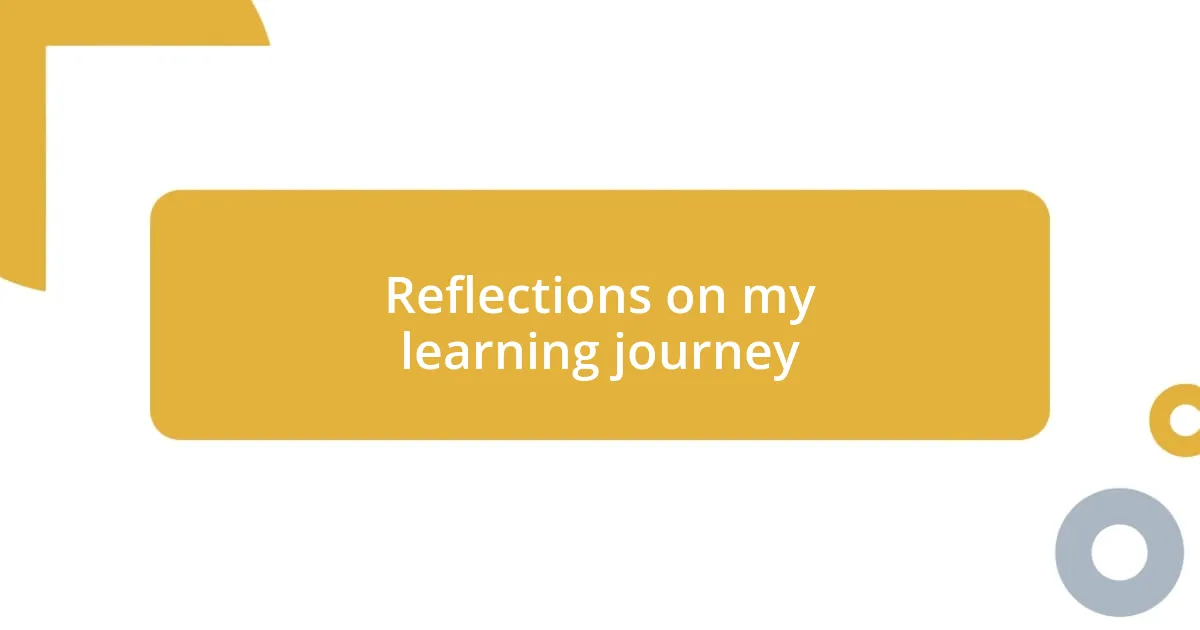
Reflections on my learning journey
Learning Swift concurrency has been a transformative experience for me, not just technically but emotionally as well. I recall the moment when I successfully executed my first async function without any hiccups. It felt like hitting that sweet spot where everything aligns—pure elation! Have you ever felt that rush when the code you’ve been struggling with finally works? It’s those small victories that fuel my passion and make the journey worthwhile.
As I dove deeper, I noticed that concurrency wasn’t merely about speeding up processes; it reshaped my entire approach to problem-solving. I remember grappling with a particularly tricky scenario where I needed to optimize data fetching. I felt overwhelmed, almost ready to throw in the towel. But by breaking down the problem into manageable tasks using structured concurrency, I found clarity and a renewed sense of confidence. Isn’t it incredible how sometimes a fresh perspective can illuminate paths we never thought existed? Those moments of realization have been some of my favorites.
Reflecting on my journey, I often marvel at how much I’ve grown and adapted. The challenges I faced with delayed responses and race conditions have transformed from anxiety-inducing frustrations to exhilarating challenges that I now embrace. It strikes me how learning Swift concurrency is not just about acquiring technical skills; it’s about developing resilience and a problem-solving mindset. How often do we get to transform our struggles into strengths? For me, it’s a constant reminder that learning is an ever-evolving adventure, and I can’t wait to see where it leads next.














